Línea Córdoba - Málaga
Infraestructuras principales: Túneles y viaductos
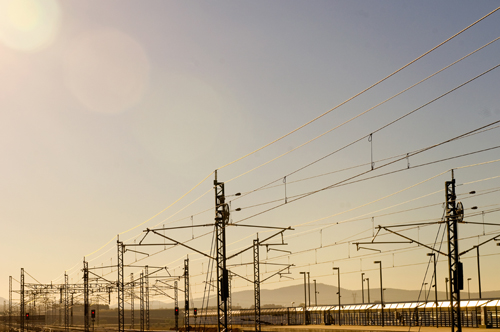
La vía de alta velocidad discurre, alcanzando Málaga, desde las llanuras de Córdoba por el valle de Abdalajís y la sierra de Huma, a través de un recorrido en el que se construyeron quince viaductos y ocho túneles.
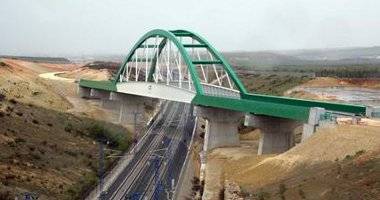
Algunos de ellos resultan especialmente interesantes por sus dimensiones, el diseño o bien por el sistema empleado en su construcción.
El viaducto sobre el río Genil, es el más largo de la línea con 1.390 m. Los del Espinazo y Jévar están separados entre sí por tan solo 32 metros de distancia.
Por su altura y longitud es significativo el Viaducto del Arroyo de las Piedras, en el término municipal de Álora. Fue construido para salvar el desnivel que el trazado encuentra a la salida sur del túnel de Abdalajís. Es el segundo en extensión de toda la línea y consta de 19 pilas y 20 vanos, con luces de hasta 63,5 metros y pilas de hasta 93,5 metros de altura. Su tablero es mixto, construido en acero y hormigón.
Viaductos principales:
- Río Guadalquivir, 880 metros
- Río Genil, 1.390 metros
- Arroyo del Salado, 924 metros
- Espinazo, 870 metros
- Jévar, 837 metros
- Arroyo de las Piedras, 1.220 metros
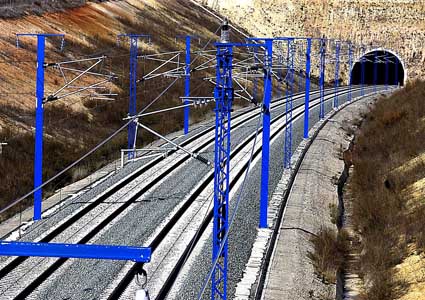
Para atravesar la Cordillera Bética se han construido diversos túneles cuya longitud total suma 19 kilómetros.
La llegada de la alta velocidad significó para la ciudad de Málaga una nueva configuración urbana en la que el soterramiento de las vías permitió la integración del ferrocarril en la capital malagueña. El pasillo soterrado comprende dos túneles paralelos y adosados de 1.932 metros de longitud, uno para dos vías de ancho UIC y el otro para dos vías de ancho ibérico.
Túneles principales:
- Gobantes, 1.792 metros
- Espartal, 2.002 metros
- Cártama, 2.424 metros
- Gibralmora, 3.217 metros
- Abdalajís, túnel bitubo de 7.280 y 7.300 metros
Túnel de Abdalajís
El más importante de todos los túneles de la línea, por su longitud (más de 7 km) y por la complejidad del terreno atravesado es el túnel de Abdalajís que, desde las inmediaciones de la estación de Antequera Santa Ana y al oeste del embalse del Guadalhorce, atraviesa la sierra del mismo nombre.
Sus más de siete kilómetros de longitud atraviesan una zona de gran complejidad hidrogeológica, en la que el subsuelo es una continua cadena de acuíferos. Los estudios realizados en la fase de proyecto aconsejaron optar por el trazado acometido, como el de menor afección posible a los acuíferos, ya que la alternativa por la zona de El Torcal de Antequera afectaba a acuíferos de mayores dimensiones y obligaba a la realización de túneles de mayor longitud.
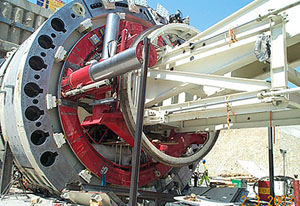
El túnel es de tipología bitubo, con dos tubos comunicados entre sí por un total de 19 galerías de evacuación y seguridad separadas cada 350 metros.
Los trabajos de perforación se iniciaron en noviembre de 2003 y se desarrollaron durante 26 meses. Dos tuneladoras de doble escudo se encargaron de la excavación principal. La tuneladora del tubo Este fue bautizada con el nombre de La Alcazaba, mientras que la del túnel Oeste recibió el nombre de La Mezquita.
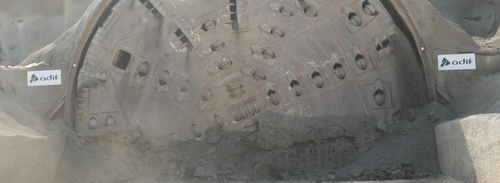
El túnel requirió un tratamiento de inyección masiva de hormigón y la ejecución de un anillo de impermeabilización del revestimiento interior, que mejora el sellado y permite la recuperación de los acuíferos que interfería.
Durante las obras una de las máximas prioridades fue el compromiso con el entorno natural, el cuál forma parte de la política de Responsabilidad Social de Adif. Los trabajos siguieron de manera estricta las directrices del Estudio Informativo y de la Declaración de Impacto Ambiental. En total, se destinaron 12,8 millones de euros a garantizar la integración ambiental de la obra, mediante la adopción de medidas de protección de la fauna, la vegetación y el sistema hidrológico, así como otras destinadas a la recuperación ambiental y la integración paisajística.

